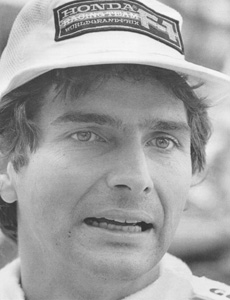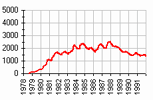Гонщики, P | |
Piquet, Nelson Курсивом отмечены гонщики, |
| Нельсон ПикеPiquet, NelsonPiquet Souto Maior, Nelson |
 (c) 'Who is Who' by Steve Small, 2000 Родился: 17.08.1952 Рио-де-Жанейро Сезонов в Ф1: Лет в Ф1: 14 Гран При: Старты: 203* *не стартовал: 5 Победы: - подряд: 2 Подиумы: - подряд: 9 Поул-позиции: - подряд: 3 Первый ряд: - подряд: 5 Быстрые круги: - подряд: 3 Лучший финиш: Лучший старт: 1 Дубли: Хет-трики: 3 Лидирование старт/финиш: Большие шлемы: |
Год | Команда | Шасси |
Three world titles testify to the standing of Nelson Piquet, yet many begrudge him his successes, feeling they were not earned in the manner of a true champion. Of course the Brazilian couldn't have cared less. Racing above all to please himself, he went about things in his own way and that approach generally paid dividends. Never happier than when he had some technical advantage to exploit, Nelson felt no embarrassment at using that edge to beat his hapless rivals.
Having raced karts and Super Vee cars in Brazil, Nelson came to Europe in 1977 to tackle the European F3 series, winning two rounds after switching to a Ralt chassis. The following year he concentrated on F3 once more, this time in Britain. His initial object was to beat his Brazilian rival Chico Serra, who was getting a good press back at home, but eventually it was Derek Warwick who was to be his sternest challenger for the two championships on offer that year. They ended up taking one apiece, but by now Nelson was interesting Formula 1 teams. Mo Nunn gave him a debut in his forgiving Ensign, before the heavy steering of the BS Fabrications McLaren posed more searching questions. However, his practice performance in the third Brabham-Alfa at Montreal prompted Bernie Ecclestone to offer him a contract for 1979.
A superb drive in the Race of Champions took him into second place, and though the Grand Prix season yielded little by way of hard results Nelson was clearly a driver destined for the very top. When Lauda quit towards the end of the season Brabham did not have far to look for a new team leader to handle the Cosworth-powered BT49 in 1980. Nelson took three Grand Prix wins and finished runner-up to Alan Jones that year, and was to go all the way in 1981. After a tense and closely fought season, Piquet typically did just enough to edge out Carlos Reutemann in the final race at Caesars Palace. Realising that turbo power was now a necessity, Brabham spent the 1982 season bringing their new BMW-engined car to a competitive state - something achieved when Nelson won in Montreal - and then trying to make it reliable. The knowledge gained was then incorporated into the design of Gordon Murray's flat-bottomed 1983 contender which was tailored to the mid-race refuelling tactics the team had pioneered the previous year. At the wheel of the splendid little BT52, Piquet battled with Prost for the title, whittling away the Frenchman's lead before taking the crown at the last gasp at Kyalami. In 1984 the Brabham was no match for the McLarens and even Nelson was left in their wake but, digging deep, he conjured up back-to-back wins in Montreal and Detroit to salvage something from a disappointing year. The end of the superb Piquet-Brabham relationship came in 1985, with Nelson hamstrung by running uncompetitive Pirellis, but there was one last win, at Paul Ricard, when the hard-compound Italian tyres held sway.
Piquet was ready to better his financial position and signed for Williams for 1986. The season should have been a walk-over for the Didcot team, but the atmosphere soon became strained as Nigel Mansell refused to play second fiddle and set about launching his own title bid. The upshot was that Alain Prost stole the championship at the death, leaving Nelson fuming over Williams' indecisive handling of team tactics. Honda were not pleased either, and would switch to McLaren at the end of the following season. Piquet knew the score in 1987, and set about winning the title despite Mansell. With a good deal of fortune and some help from his luckless team-mate, Nelson did just that. His third title may have been achieved more by stealth than by absolute speed, but the results justified the means in Piquet's book. A two-year spell at Lotus was a complete disaster for all concerned. The massive retainer Nelson picked up from Camel was out of all proportion to his on-track return, and while his bank balance may never have been higher than it was at the end of 1989, never was his stock so low. His subsequent inclusion in the Benetton team for 1990 was greeted with huge surprise, but as the season wore on the wisdom of the move became apparent. Nelson struck up a good working relationship with John Barnard and the pair brought the Benetton B190 to a very competitive pitch, Nelson exploiting others' misfortune to win both the Japanese and Australian GPs. Even his sternest critics were forced to admit that his drive in Adelaide was right out of the top drawer. He was to take one more very fortuitous (but highly satisfying) win at Mansell's expense in Canada the following year before being swept away amid the personnel changes that engulfed the team that season.
With no suitable F1 offers available, Piquet decided to try his hand at the Indianapolis 500 in 1992. Unfortunately a huge crash in practice left him with very badly crushed feet and legs, easily the most severe injuries he had suffered in his long career, and his rehabilitation was long and painful. Nelson vowed never to return to the cockpit but, once fit, he was back at the Brickyard in 1993, and by qualifying for the race he finished the job left uncompleted 12 months earlier.
Competing now mainly for fun, Nelson has since renewed his links with BMW and has raced a 320i tourer in long-distance events both at home and in Europe, usually with Ingo Hoffmann and Johnny Cecotto. Piquet has also made a couple of visits to Le Mans with the Bigazzi McLaren F1 GTR, finishing eighth in 1996 with Cecotto and Danny Sullivan.
(c) 'Who is Who' by Steve Small, 2000
| © WildSoft, 1995-2020 |


